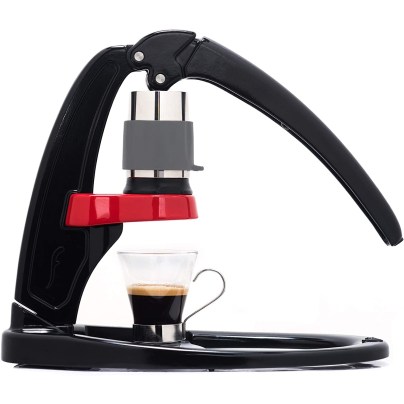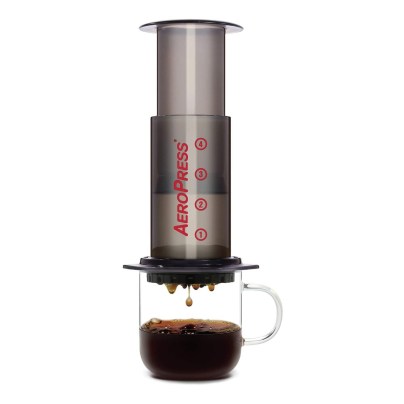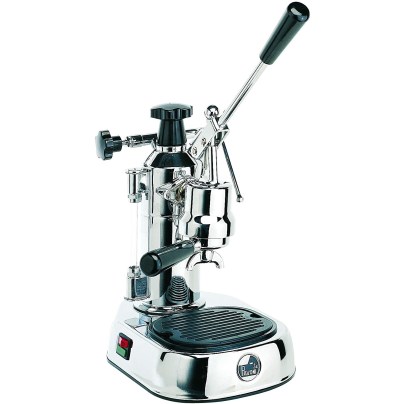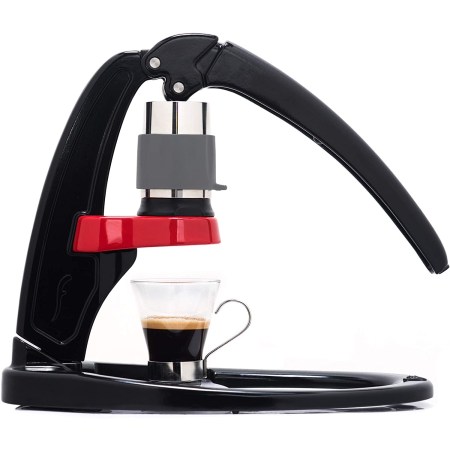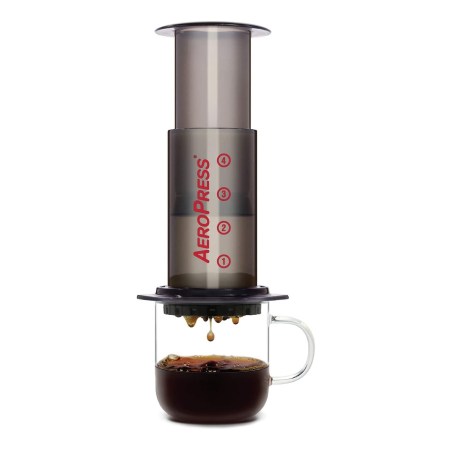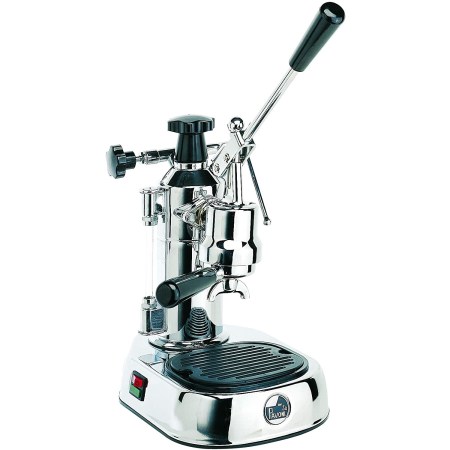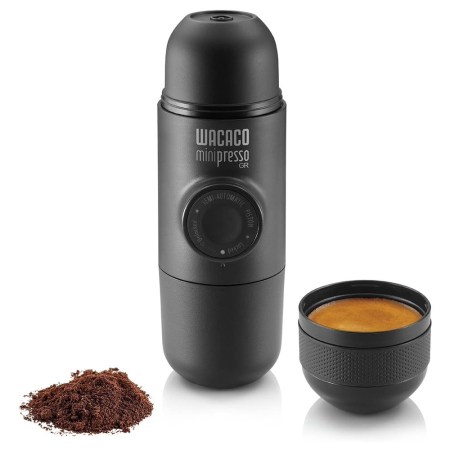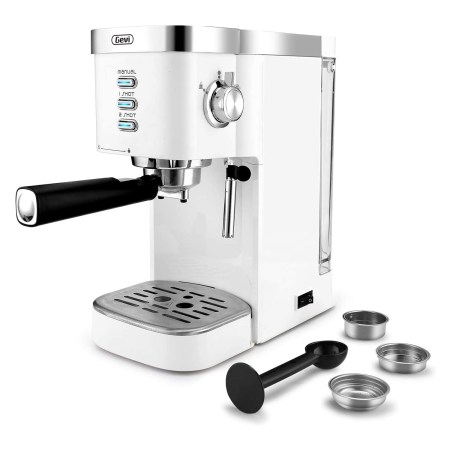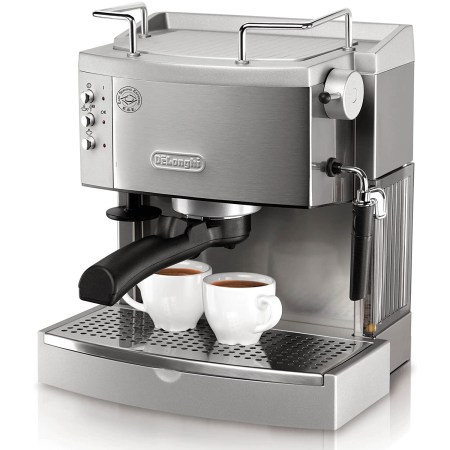We may earn revenue from the products available on this page and participate in affiliate programs. Learn More ›
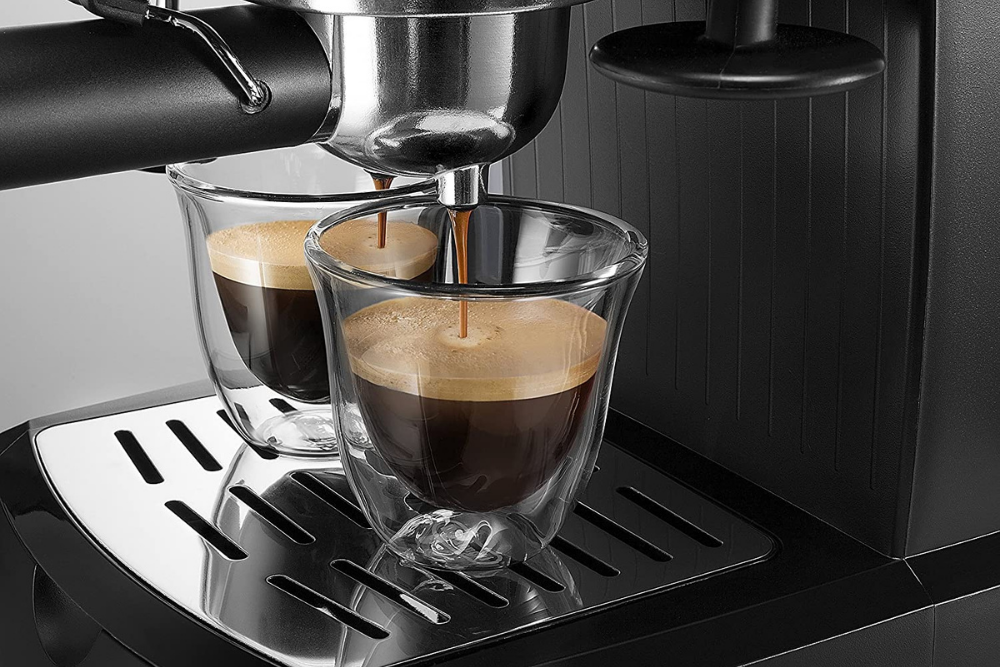
For coffee enthusiasts, making their morning brew is a ritual for the senses. Coffee connoisseurs who prefer a latte or a cappuccino in their mug may want to purchase an espresso machine.
Espresso is a concentrated cup of coffee made by forcing hot water through packed coffee grounds. Though automatic machines simplify the process, manual versions are the espresso artist’s preferred device for pulling a shot. The best manual espresso machine lets you control the water flow over the grounds with a lever or pump. Some devices also include a pressure gauge, grinder, and a built-in boiler or heating source. Making the perfect brew is an art that takes practice to perfect. Below, find picks for the best manual espresso machine in a range of categories.
- BEST OVERALL: Flair Espresso Maker – Classic: All manual
- BEST BANG FOR THE BUCK: AeroPress Coffee and Espresso Maker
- BEST LUXURY: La Pavoni EPC-8 Europiccola Lever Espresso Machine
- BEST PORTABLE: Wacaco Minipresso Portable Espresso Machine
- BEST MIDRANGE ELECTRIC: Barsetto Espresso Machines Cappuccino Machine
- BEST UPGRADE ELECTRIC: De’Longhi 15 bar Pump Espresso Maker
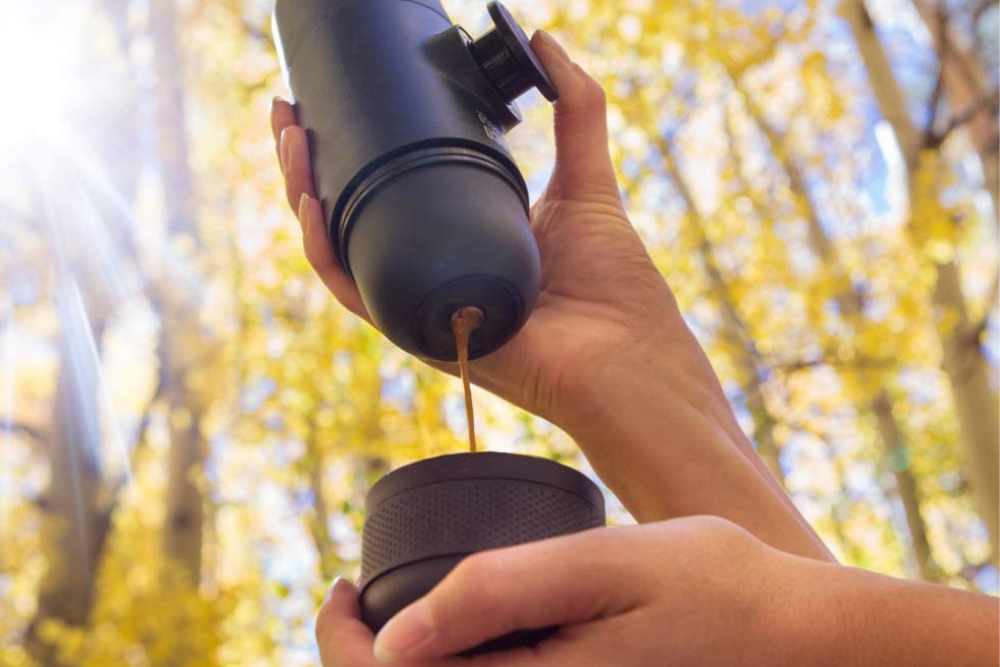
Types of Manual Espresso Machines
Not only does the user’s level of control vary among espresso machines, but the mechanism that pushes the water through the grounds varies as well. Before choosing the best manual espresso machine for your needs, learn about their different features.
Spring Piston
A spring piston machine uses a manually operated lever to trigger an internal calibrated spring and piston to push out the water, which is heated in an internal boiler. To cock the spring, pull down a lever. Once the lever is released, it slowly comes up, and water is pushed out through the coffee grounds as the pressure decreases. Spring systems provide consistent pressure from shot to shot.
Direct Lever
In a direct lever machine, the user pulls down the lever to control the pressure, so it may take more patience and practice to perfect the process. Because it allows the ability to customize the process, some coffee aficionados prefer this type of total control over pressure, speed, and volume. Direct lever machines are generally less expensive than spring piston versions, and their parts are simple, more durable, and last longer than more complicated models.
Hand Pumped
To operate a hand-pumped espresso machine, simply press the pump, which makes this type of machine easily portable. They don’t require electricity or batteries. Hand-pumped machines are affordable and compact, and some even have an integrated cup and carrying case.
Semiautomatic
For those willing to sacrifice some manual control for an easier brewing process, a semiautomatic espresso maker may be a good choice. Instead of a lever, a mechanical pump activates the piston. The pressure of the pump is measured in bars, a measuring unit that represents atmospheric pressure. One bar equals the earth’s atmospheric pressure at sea level. Shoppers should choose a machine with 9 to 15 bars of pressure. The higher the number, the less time it takes to pull a shot, which can result in a different flavor.
These machines often include programmable settings to control brewing variables, but the user decides when to stop the water flow. The owner also must grind the coffee and tamp, or pack, the beans. These models also include a manually operated milk frothing mechanism. The water capacity varies by model, from a couple of shots to a dozen. Some come with a fully automatic setting.
What to Consider When Choosing the Best Manual Espresso Machine
Keep in mind a few considerations while shopping for a machine. The best manual espresso machine depends on the model’s size, material, ease of use, and versatility.
Size
Whether making one espresso a day or 10, choose a model that suits the needs and available counter space. The size of the machine depends on the capacity of the water tank as well as other features such as the lever and milk carafe.
The simplest models, such as a hand-pump version, don’t include an internal boiler or steam wand so they’re smaller and weigh less. Models with an internal heat source need more space, but they can still be compact, depending on their water capacity. Smaller versions generally include a single boiler that’s used for both brewing and steaming.
Material
The best manual espresso machines are constructed from stainless steel, brass, chrome, and aluminum. These materials not only look good but also are durable and long-lasting. In machines with plastic parts, such as many semiautomatic models, look for BPA-free options.
In internal boiler machines, aluminum heats and transfers heat quickly, but brass boilers provide better temperature stability. Some high-end machines have copper boilers, which also offer temperature consistency and stability. Copper boilers often are covered in plated metal to prevent leaching of the metal into the coffee. The effectiveness of stainless steel boilers varies depending on the quality. Many higher-end options have thick stainless steel boilers that heat quickly and keep temperatures stable.
Ease of Use
Making a perfect cup of espresso takes patience and practice. A fully manual direct-lever or hand-pump machine usually takes the most skill to master. The user controls each step of the process, from controlling the pressure to grinding the coffee beans. There’s a large margin for error, but a high potential for satisfaction.
A spring piston machine requires a great deal of manual involvement, but the spring mechanism supplies even pressure and consistency from shot to shot.
For beginners or those who don’t have the time or patience for a fully manual machine, a semiautomatic model often is the easiest to use. These machines still require some hands-on involvement to set the temperature, pack the grind, and control the amount of water, but the machine controls the pressure and other brewing variables.
Versatility
Operating a manual machine is typically a one-step process, but some contain an internal boiler and steam wand for making lattes and cappuccinos. Cordless models are portable, so they’re good for business travel or even camping.
Semiautomatic machines offer more versatility. Some allow the user to brew tea or cappuccino as well as espresso, or they contain a filter for use with coffee pods. Others let you switch to a fully automatic setting, which is convenient when entertaining or if you’re short on time.
Aesthetic
Manual espresso machine design varies from contemporary to vintage styles. Semiautomatic versions are often modular, featuring a combination of plastic and stainless steel parts.
The old-world style of lever espresso machines sets them apart from modern automatic models, so they can serve as a centerpiece in a kitchen. These stainless steel or chrome-plated models stand out on the countertop, drawing the eye to their shiny surfaces and retro style. Newer hand-pump models often feature a contemporary design, such as a minimal cylinder.
Portability
Serious espresso drinkers may want to take their brewing power on the road. Manual hand-pump devices are a good option since they’re compact and don’t need electricity. Users must add hot water to the machine before making espresso. Lever models are available that can be taken apart and tucked into a bag for easy transport. Look for machines that include a travel case and an integrated cup and scoop.
Cleaning and Maintenance
Keeping an espresso machine clean is required to avoid mineral buildup and dirt, which can affect the taste of the coffee. Machines that disassemble are the easiest models to clean, and some contain dishwasher-safe components.
To keep the exterior shiny, wipe down nonremovable parts with a damp cloth. Cleaning and maintaining the internal components requires a bit more work. Mineral deposits from tap water can clog the machine and affect the taste of the espresso, so the machine should be “descaled” periodically. Some automatic machines have a cleaning and descaling cycle that makes cleaning easier. If the machine doesn’t have that feature, users should run a liquid cleaner through it, such as citric acid, white vinegar, or a commercial descaling product. Read the machine’s manual for specific guidance on cleaning.
Our Top Picks
Based on the above shopping considerations, here are picks for some of the best espresso machines in a range of categories.
Best Overall
Flair Espresso Maker – Classic: All manual
See ItThis fully manual machine uses human power instead of electricity to operate. An aluminum stand and stainless steel brewing head make the Flair Espresso Maker durable and built to last. The machine breaks down in three parts―a base, post, and brewing head―making it easy to clean or transport in the included padded travel bag. Since it doesn’t connect to a power source, users must grind the coffee beans and heat the water separately. The cylinder can hold just over 2 ounces of water at a time, enough for a 1.4-ounce shot of espresso.
Best Bang for the Buck
AeroPress Coffee and Espresso Maker
See ItThe AeroPress is a good pick for those who take their caffeine to go. Though it’s small, it can brew espresso shots or make 1 to 3 cups of coffee per pressing. The device has a brew time of about 1 minute, minimizing the bitterness that longer steeping sometimes creates. The AeroPress also makes cold brew coffee in about 2 minutes.
The press comes with a paper microfilter that eliminates grit and makes cleanup easier. The package also includes a funnel, scoop, and stirrer. The unit is made of phthalate- and BPA-free plastic. Since it’s manual, users must grind the beans and boil water separately.
Best Luxury
La Pavoni EPC-8 Europiccola Lever Espresso Machine
See ItLa Pavoni’s eight-shot machine, which has a water capacity of 20 ounces, can make two shots of espresso at a time. A cappuccino attachment and steam wand come with the machine to create foam and heat milk for cafe-style drinks. The hand-operated lever design uses steam to operate the piston, while an internal thermostat monitors pressure throughout the process. The chrome-plated design features solid brass boilers and stainless steel parts, and a removable drip tray makes cleanup easy. The company offers an instructional video to help users get started.
Best Portable
Wacaco Minipresso Portable Espresso Machine
See ItUse this compact hand-pump Wacaco Minipresso espresso maker anywhere, from the office to the great outdoors, because it doesn’t need electricity. Standing just under 7 inches and weighing less than a pound, this machine can be stashed in a backpack or tote bag. The Minipresso is easy to use: Just pack ground coffee into the filter basket, add boiling water, and pump to make a single shot of espresso. The Minipresso’s tank holds 2.35 ounces of water, enough to make a single shot. Made of food-grade plastic, it’s BPA-free.
Wacaco sells accessories separately that make the Minipresso even more versatile, including a larger water tank, carrying case, and additional filter baskets that can be stored inside the body.
Best Midrange Electric
Barsetto Espresso Machines Cappuccino Machine
See ItBarsetto’s two-in-one machine features a transparent water tank that can hold up to 50 ounces of water and is removable for easy cleaning. A boiler heats the water, and a powerful pump pushes 15 bars of pressure through coffee grounds to extract espresso. A double-layer filter and double-cup splitter make it possible to brew two cups of espresso at the same time.
The machine has a manual steam wand for milk frothing to make cappuccinos and lattes. Two thermostats allow for the water and steam pressure to be controlled separately. Made from stainless steel, the unit is sturdy and attractive, and its control buttons and indicator light make it easy to operate.
Best Upgrade Electric
De’Longhi 15 bar Pump Espresso Maker
See ItThe three-in-one filter holder can accommodate pods or ground coffee for one or two shots of espresso. A manual milk frother means it also can craft cappuccinos or lattes. A removable tank holds 44 ounces of water, and a water-level indicator lets users know when it needs a refill.
A powerful 15-bar pump with controls for manual use lets users modify the espresso-making process to suit their taste preference. Two thermostats enable users to control the water and steam pressure separately. Both its removable water tank and drip tray are dishwasher safe.
FAQs About Manual Espresso Machines
If you still have questions about espresso machines, read the answers to these frequently asked questions below.
Q. Why should I use a manual espresso machine?
A manual espresso machine provides total control over the espresso-making process, from tamping the coffee grounds to controlling extraction time. The machine lets you customize a shot to your preference.
Q. How do I clean my manual espresso machine?
To keep the exterior shining, wipe down nonremovable parts with a damp cloth. To maintain the interior where mineral deposits from tap water can build up, descale the machine. To descale it, simply run a cleaner through the machine, such as citric acid, white vinegar, or a commercial descaling product. Read your product manual for specific guidance on cleaning your machine.
Q. How long will my manual espresso machine last?
If maintained properly, a manual espresso machine can last many years. Simple machines—like hand pumps and direct-lever models—have less potential for breakdown. They may last a long time.
